WMGM102 Principles of Management: Zookal Case Study Analysis
VerifiedAdded on 2023/06/10
|6
|1697
|375
Case Study
AI Summary
This assignment presents a comprehensive analysis of the Zookal case study, focusing on Ahmed Haider's decision-making strategies as the CEO and co-founder. It examines his approach to investment opportunities, distinguishing between rational and bounded rationality styles in scaling and diversifying the business. The report also addresses the influence of stakeholders on Haider's decisions. Furthermore, the assignment includes a reflection on teamwork experiences, highlighting lessons learned, benefits of collaboration, and personal growth through shared project responsibilities. The analysis concludes that Haider's future-oriented and unconventional decisions, while seemingly risky, ultimately benefited Zookal in the long run, enabling them to overcome market challenges and establish a strong position.
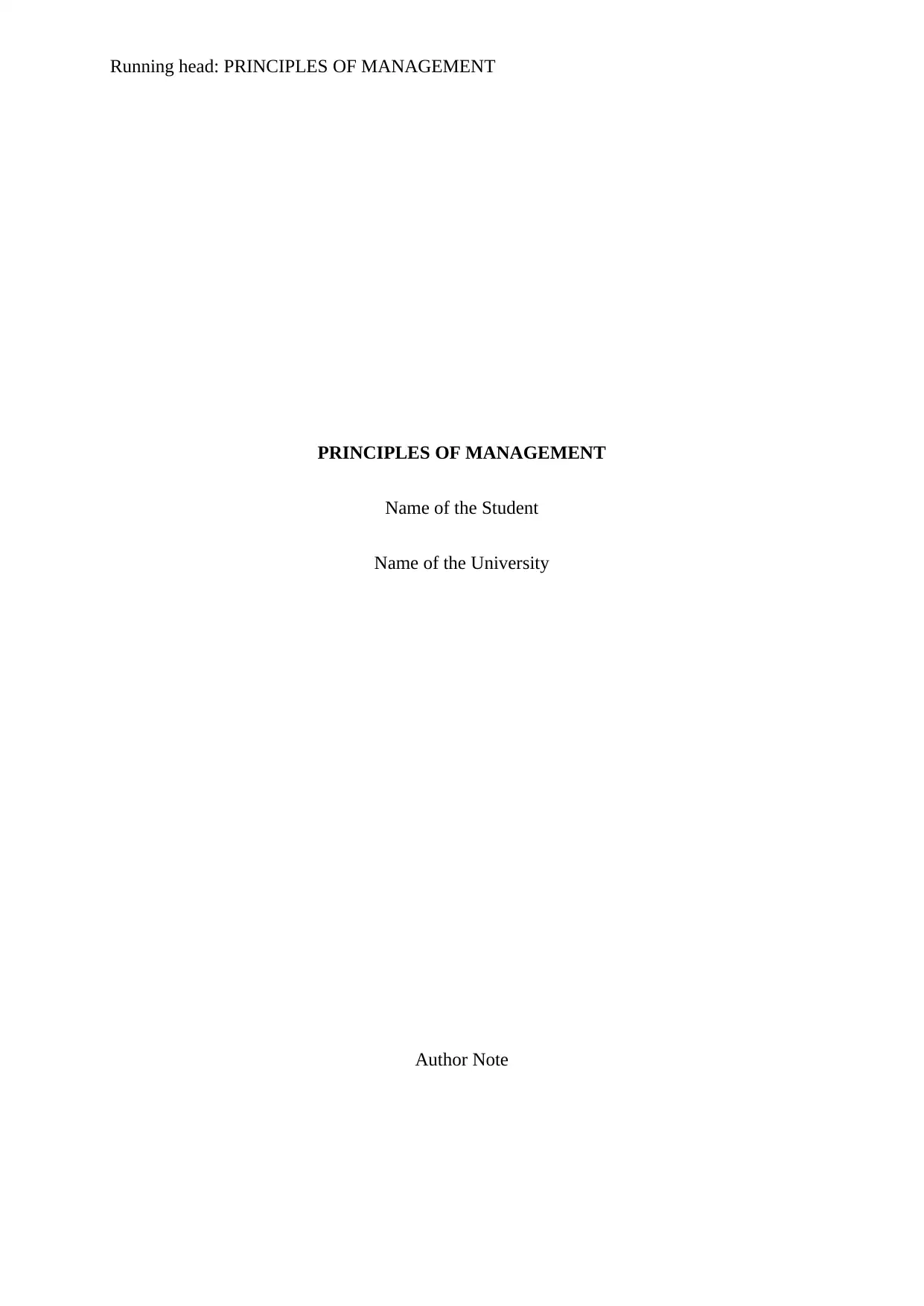
Running head: PRINCIPLES OF MANAGEMENT
PRINCIPLES OF MANAGEMENT
Name of the Student
Name of the University
Author Note
PRINCIPLES OF MANAGEMENT
Name of the Student
Name of the University
Author Note
Paraphrase This Document
Need a fresh take? Get an instant paraphrase of this document with our AI Paraphraser
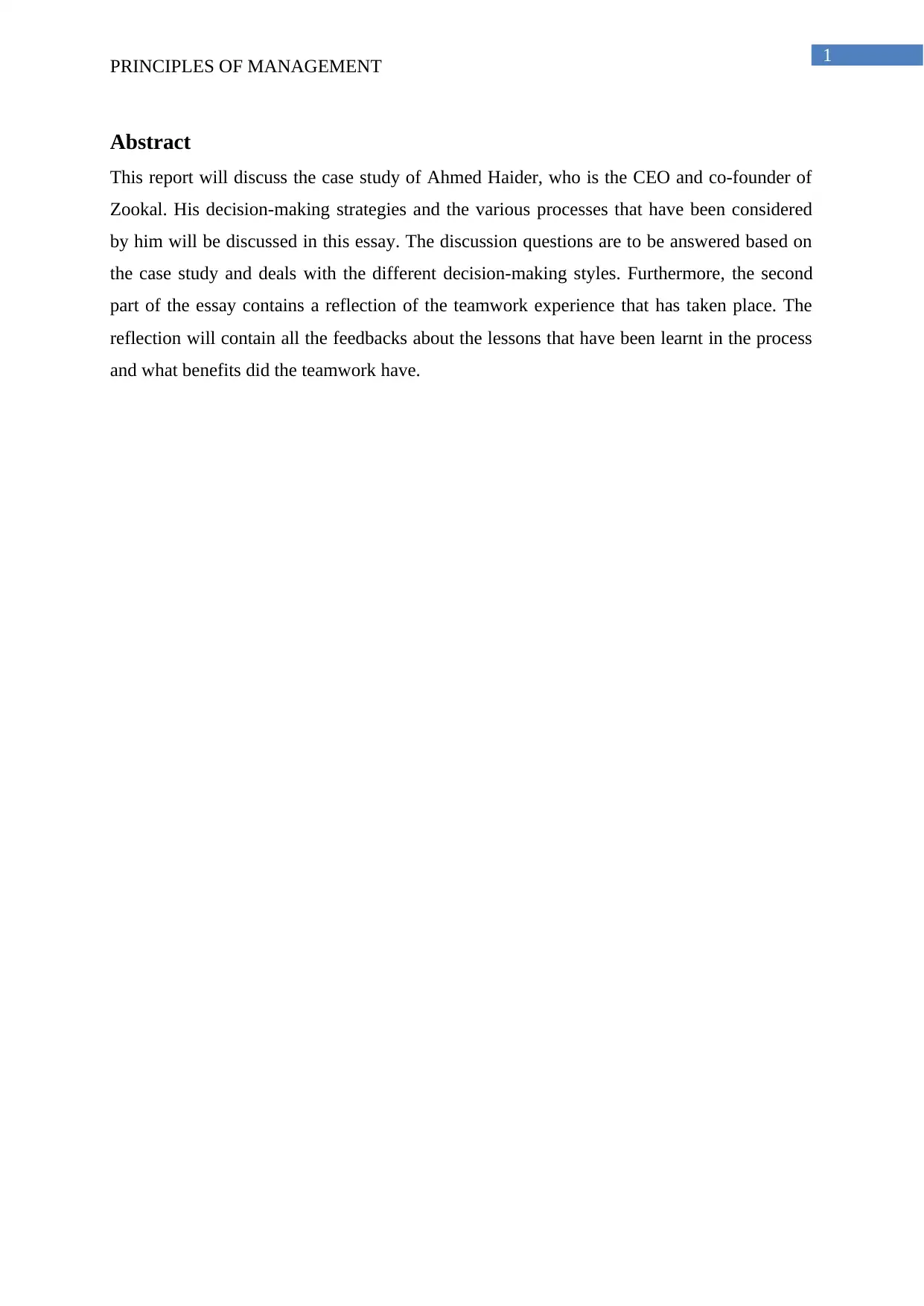
1
PRINCIPLES OF MANAGEMENT
Abstract
This report will discuss the case study of Ahmed Haider, who is the CEO and co-founder of
Zookal. His decision-making strategies and the various processes that have been considered
by him will be discussed in this essay. The discussion questions are to be answered based on
the case study and deals with the different decision-making styles. Furthermore, the second
part of the essay contains a reflection of the teamwork experience that has taken place. The
reflection will contain all the feedbacks about the lessons that have been learnt in the process
and what benefits did the teamwork have.
PRINCIPLES OF MANAGEMENT
Abstract
This report will discuss the case study of Ahmed Haider, who is the CEO and co-founder of
Zookal. His decision-making strategies and the various processes that have been considered
by him will be discussed in this essay. The discussion questions are to be answered based on
the case study and deals with the different decision-making styles. Furthermore, the second
part of the essay contains a reflection of the teamwork experience that has taken place. The
reflection will contain all the feedbacks about the lessons that have been learnt in the process
and what benefits did the teamwork have.
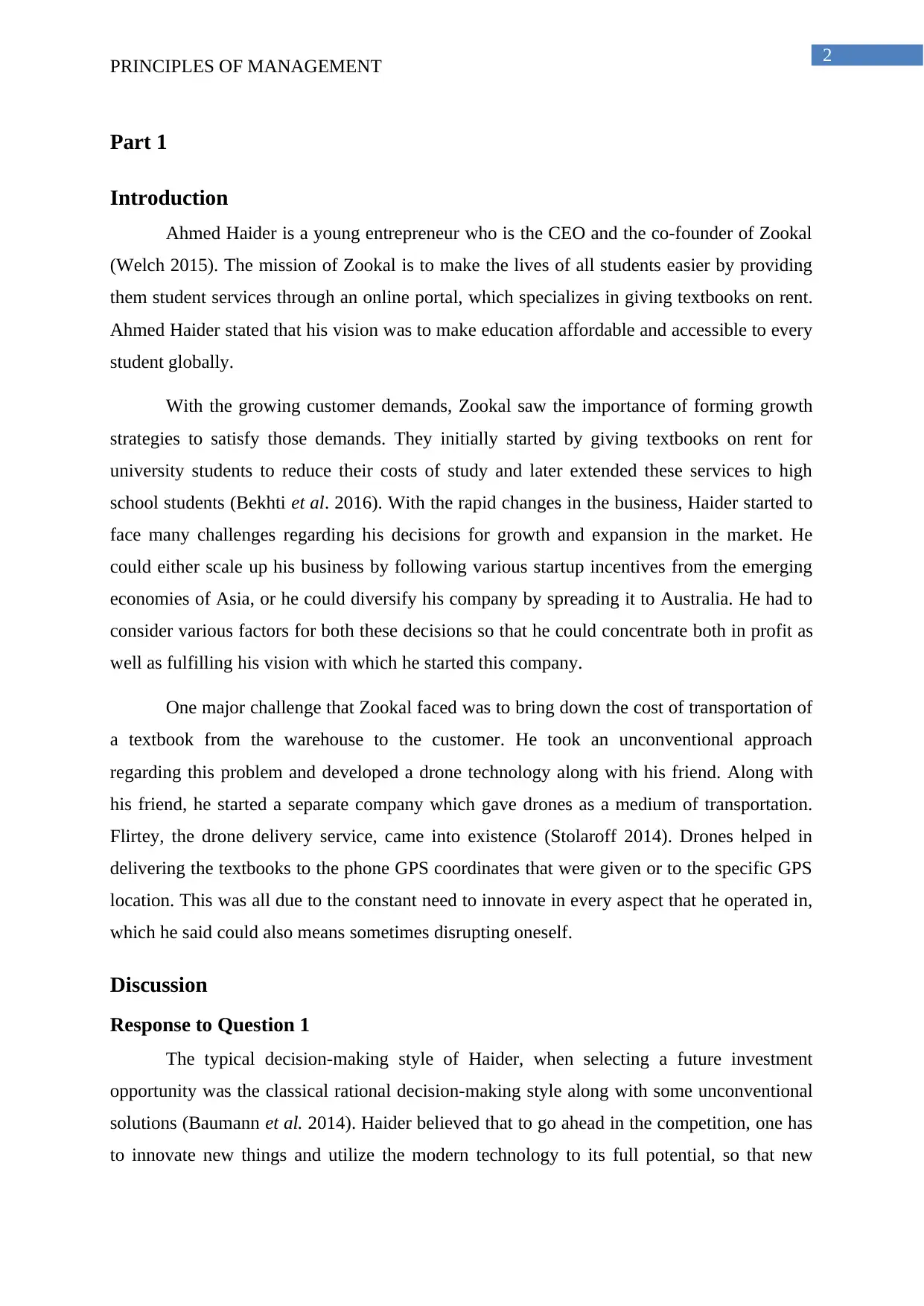
2
PRINCIPLES OF MANAGEMENT
Part 1
Introduction
Ahmed Haider is a young entrepreneur who is the CEO and the co-founder of Zookal
(Welch 2015). The mission of Zookal is to make the lives of all students easier by providing
them student services through an online portal, which specializes in giving textbooks on rent.
Ahmed Haider stated that his vision was to make education affordable and accessible to every
student globally.
With the growing customer demands, Zookal saw the importance of forming growth
strategies to satisfy those demands. They initially started by giving textbooks on rent for
university students to reduce their costs of study and later extended these services to high
school students (Bekhti et al. 2016). With the rapid changes in the business, Haider started to
face many challenges regarding his decisions for growth and expansion in the market. He
could either scale up his business by following various startup incentives from the emerging
economies of Asia, or he could diversify his company by spreading it to Australia. He had to
consider various factors for both these decisions so that he could concentrate both in profit as
well as fulfilling his vision with which he started this company.
One major challenge that Zookal faced was to bring down the cost of transportation of
a textbook from the warehouse to the customer. He took an unconventional approach
regarding this problem and developed a drone technology along with his friend. Along with
his friend, he started a separate company which gave drones as a medium of transportation.
Flirtey, the drone delivery service, came into existence (Stolaroff 2014). Drones helped in
delivering the textbooks to the phone GPS coordinates that were given or to the specific GPS
location. This was all due to the constant need to innovate in every aspect that he operated in,
which he said could also means sometimes disrupting oneself.
Discussion
Response to Question 1
The typical decision-making style of Haider, when selecting a future investment
opportunity was the classical rational decision-making style along with some unconventional
solutions (Baumann et al. 2014). Haider believed that to go ahead in the competition, one has
to innovate new things and utilize the modern technology to its full potential, so that new
PRINCIPLES OF MANAGEMENT
Part 1
Introduction
Ahmed Haider is a young entrepreneur who is the CEO and the co-founder of Zookal
(Welch 2015). The mission of Zookal is to make the lives of all students easier by providing
them student services through an online portal, which specializes in giving textbooks on rent.
Ahmed Haider stated that his vision was to make education affordable and accessible to every
student globally.
With the growing customer demands, Zookal saw the importance of forming growth
strategies to satisfy those demands. They initially started by giving textbooks on rent for
university students to reduce their costs of study and later extended these services to high
school students (Bekhti et al. 2016). With the rapid changes in the business, Haider started to
face many challenges regarding his decisions for growth and expansion in the market. He
could either scale up his business by following various startup incentives from the emerging
economies of Asia, or he could diversify his company by spreading it to Australia. He had to
consider various factors for both these decisions so that he could concentrate both in profit as
well as fulfilling his vision with which he started this company.
One major challenge that Zookal faced was to bring down the cost of transportation of
a textbook from the warehouse to the customer. He took an unconventional approach
regarding this problem and developed a drone technology along with his friend. Along with
his friend, he started a separate company which gave drones as a medium of transportation.
Flirtey, the drone delivery service, came into existence (Stolaroff 2014). Drones helped in
delivering the textbooks to the phone GPS coordinates that were given or to the specific GPS
location. This was all due to the constant need to innovate in every aspect that he operated in,
which he said could also means sometimes disrupting oneself.
Discussion
Response to Question 1
The typical decision-making style of Haider, when selecting a future investment
opportunity was the classical rational decision-making style along with some unconventional
solutions (Baumann et al. 2014). Haider believed that to go ahead in the competition, one has
to innovate new things and utilize the modern technology to its full potential, so that new
⊘ This is a preview!⊘
Do you want full access?
Subscribe today to unlock all pages.

Trusted by 1+ million students worldwide
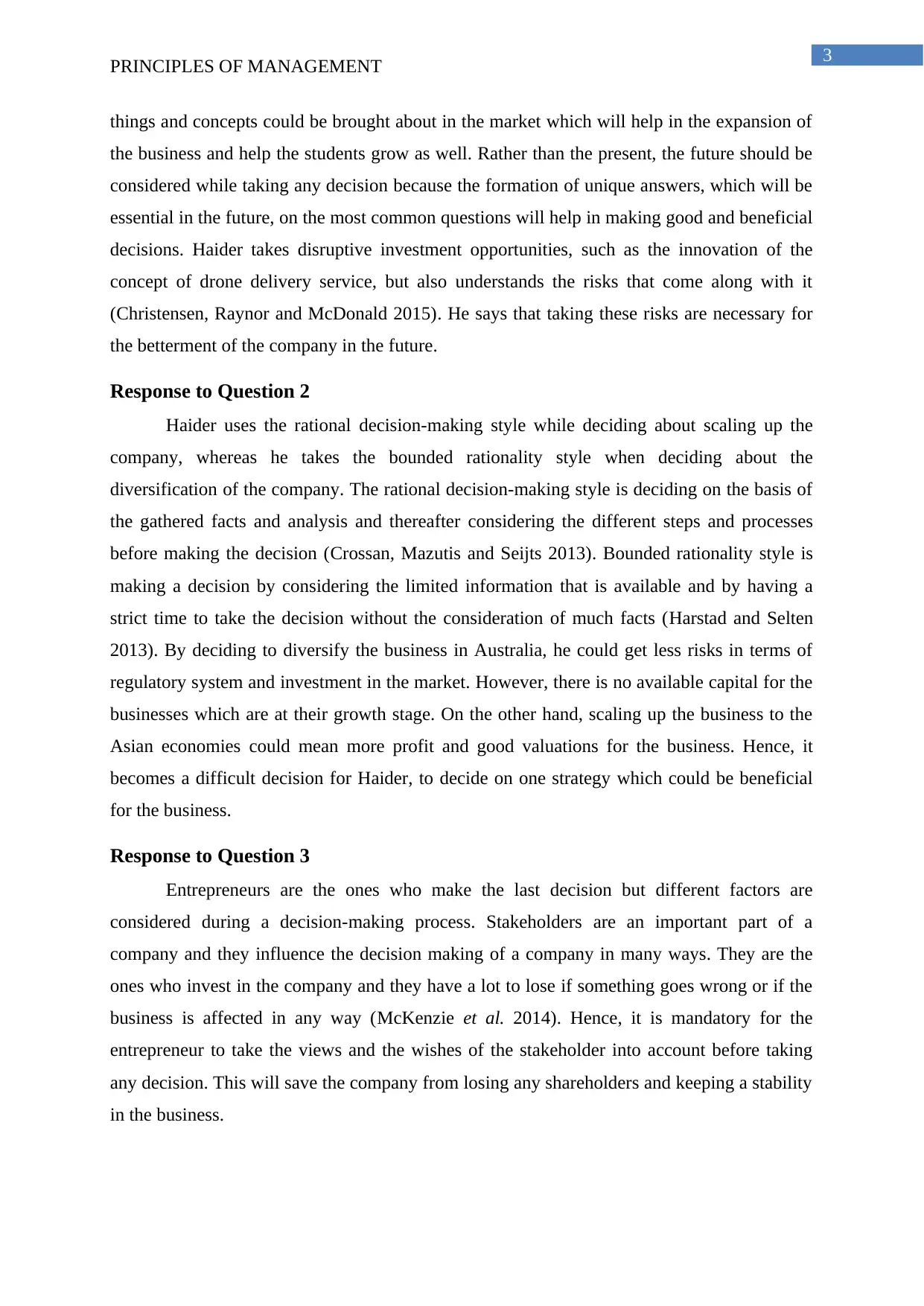
3
PRINCIPLES OF MANAGEMENT
things and concepts could be brought about in the market which will help in the expansion of
the business and help the students grow as well. Rather than the present, the future should be
considered while taking any decision because the formation of unique answers, which will be
essential in the future, on the most common questions will help in making good and beneficial
decisions. Haider takes disruptive investment opportunities, such as the innovation of the
concept of drone delivery service, but also understands the risks that come along with it
(Christensen, Raynor and McDonald 2015). He says that taking these risks are necessary for
the betterment of the company in the future.
Response to Question 2
Haider uses the rational decision-making style while deciding about scaling up the
company, whereas he takes the bounded rationality style when deciding about the
diversification of the company. The rational decision-making style is deciding on the basis of
the gathered facts and analysis and thereafter considering the different steps and processes
before making the decision (Crossan, Mazutis and Seijts 2013). Bounded rationality style is
making a decision by considering the limited information that is available and by having a
strict time to take the decision without the consideration of much facts (Harstad and Selten
2013). By deciding to diversify the business in Australia, he could get less risks in terms of
regulatory system and investment in the market. However, there is no available capital for the
businesses which are at their growth stage. On the other hand, scaling up the business to the
Asian economies could mean more profit and good valuations for the business. Hence, it
becomes a difficult decision for Haider, to decide on one strategy which could be beneficial
for the business.
Response to Question 3
Entrepreneurs are the ones who make the last decision but different factors are
considered during a decision-making process. Stakeholders are an important part of a
company and they influence the decision making of a company in many ways. They are the
ones who invest in the company and they have a lot to lose if something goes wrong or if the
business is affected in any way (McKenzie et al. 2014). Hence, it is mandatory for the
entrepreneur to take the views and the wishes of the stakeholder into account before taking
any decision. This will save the company from losing any shareholders and keeping a stability
in the business.
PRINCIPLES OF MANAGEMENT
things and concepts could be brought about in the market which will help in the expansion of
the business and help the students grow as well. Rather than the present, the future should be
considered while taking any decision because the formation of unique answers, which will be
essential in the future, on the most common questions will help in making good and beneficial
decisions. Haider takes disruptive investment opportunities, such as the innovation of the
concept of drone delivery service, but also understands the risks that come along with it
(Christensen, Raynor and McDonald 2015). He says that taking these risks are necessary for
the betterment of the company in the future.
Response to Question 2
Haider uses the rational decision-making style while deciding about scaling up the
company, whereas he takes the bounded rationality style when deciding about the
diversification of the company. The rational decision-making style is deciding on the basis of
the gathered facts and analysis and thereafter considering the different steps and processes
before making the decision (Crossan, Mazutis and Seijts 2013). Bounded rationality style is
making a decision by considering the limited information that is available and by having a
strict time to take the decision without the consideration of much facts (Harstad and Selten
2013). By deciding to diversify the business in Australia, he could get less risks in terms of
regulatory system and investment in the market. However, there is no available capital for the
businesses which are at their growth stage. On the other hand, scaling up the business to the
Asian economies could mean more profit and good valuations for the business. Hence, it
becomes a difficult decision for Haider, to decide on one strategy which could be beneficial
for the business.
Response to Question 3
Entrepreneurs are the ones who make the last decision but different factors are
considered during a decision-making process. Stakeholders are an important part of a
company and they influence the decision making of a company in many ways. They are the
ones who invest in the company and they have a lot to lose if something goes wrong or if the
business is affected in any way (McKenzie et al. 2014). Hence, it is mandatory for the
entrepreneur to take the views and the wishes of the stakeholder into account before taking
any decision. This will save the company from losing any shareholders and keeping a stability
in the business.
Paraphrase This Document
Need a fresh take? Get an instant paraphrase of this document with our AI Paraphraser
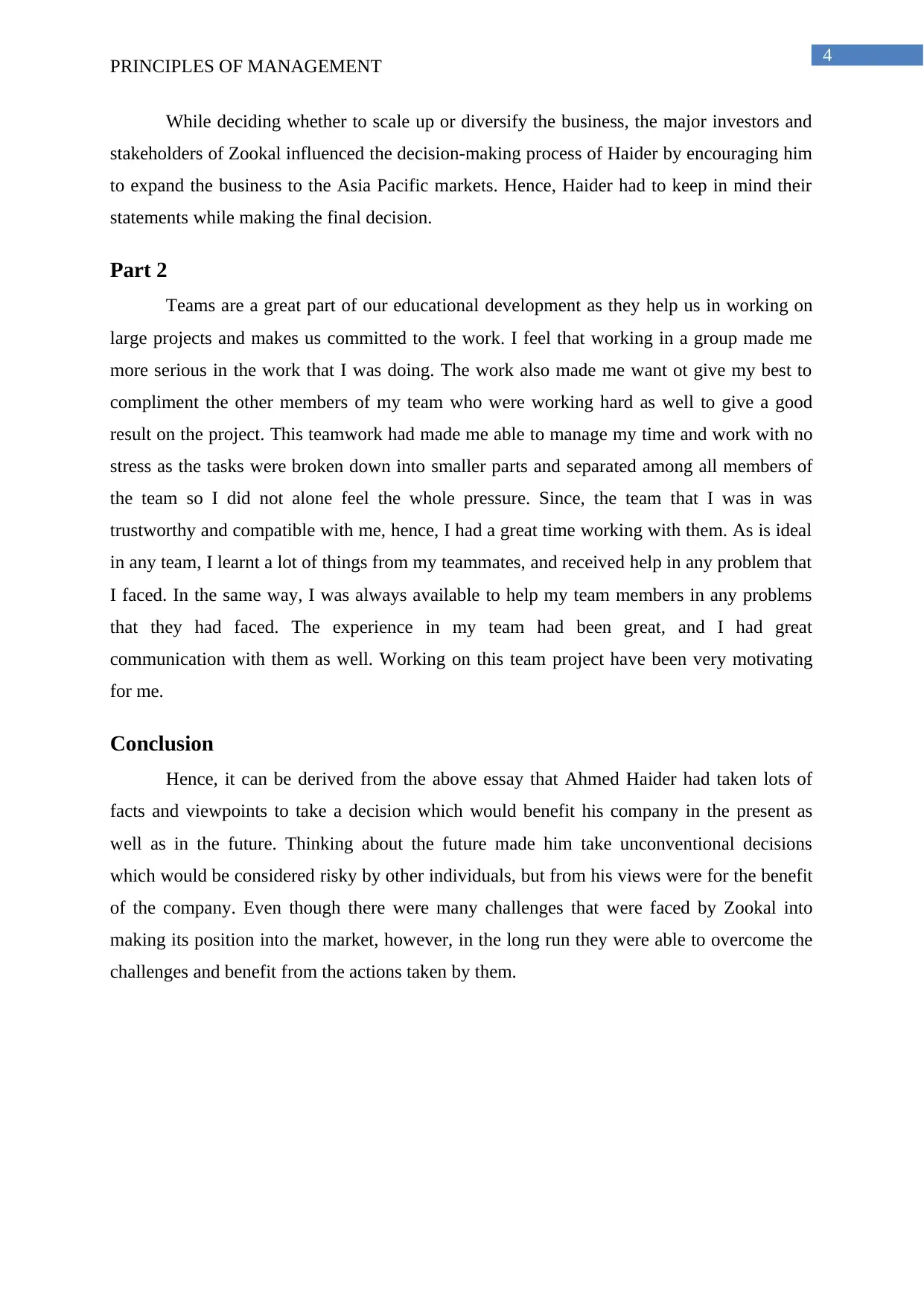
4
PRINCIPLES OF MANAGEMENT
While deciding whether to scale up or diversify the business, the major investors and
stakeholders of Zookal influenced the decision-making process of Haider by encouraging him
to expand the business to the Asia Pacific markets. Hence, Haider had to keep in mind their
statements while making the final decision.
Part 2
Teams are a great part of our educational development as they help us in working on
large projects and makes us committed to the work. I feel that working in a group made me
more serious in the work that I was doing. The work also made me want ot give my best to
compliment the other members of my team who were working hard as well to give a good
result on the project. This teamwork had made me able to manage my time and work with no
stress as the tasks were broken down into smaller parts and separated among all members of
the team so I did not alone feel the whole pressure. Since, the team that I was in was
trustworthy and compatible with me, hence, I had a great time working with them. As is ideal
in any team, I learnt a lot of things from my teammates, and received help in any problem that
I faced. In the same way, I was always available to help my team members in any problems
that they had faced. The experience in my team had been great, and I had great
communication with them as well. Working on this team project have been very motivating
for me.
Conclusion
Hence, it can be derived from the above essay that Ahmed Haider had taken lots of
facts and viewpoints to take a decision which would benefit his company in the present as
well as in the future. Thinking about the future made him take unconventional decisions
which would be considered risky by other individuals, but from his views were for the benefit
of the company. Even though there were many challenges that were faced by Zookal into
making its position into the market, however, in the long run they were able to overcome the
challenges and benefit from the actions taken by them.
PRINCIPLES OF MANAGEMENT
While deciding whether to scale up or diversify the business, the major investors and
stakeholders of Zookal influenced the decision-making process of Haider by encouraging him
to expand the business to the Asia Pacific markets. Hence, Haider had to keep in mind their
statements while making the final decision.
Part 2
Teams are a great part of our educational development as they help us in working on
large projects and makes us committed to the work. I feel that working in a group made me
more serious in the work that I was doing. The work also made me want ot give my best to
compliment the other members of my team who were working hard as well to give a good
result on the project. This teamwork had made me able to manage my time and work with no
stress as the tasks were broken down into smaller parts and separated among all members of
the team so I did not alone feel the whole pressure. Since, the team that I was in was
trustworthy and compatible with me, hence, I had a great time working with them. As is ideal
in any team, I learnt a lot of things from my teammates, and received help in any problem that
I faced. In the same way, I was always available to help my team members in any problems
that they had faced. The experience in my team had been great, and I had great
communication with them as well. Working on this team project have been very motivating
for me.
Conclusion
Hence, it can be derived from the above essay that Ahmed Haider had taken lots of
facts and viewpoints to take a decision which would benefit his company in the present as
well as in the future. Thinking about the future made him take unconventional decisions
which would be considered risky by other individuals, but from his views were for the benefit
of the company. Even though there were many challenges that were faced by Zookal into
making its position into the market, however, in the long run they were able to overcome the
challenges and benefit from the actions taken by them.
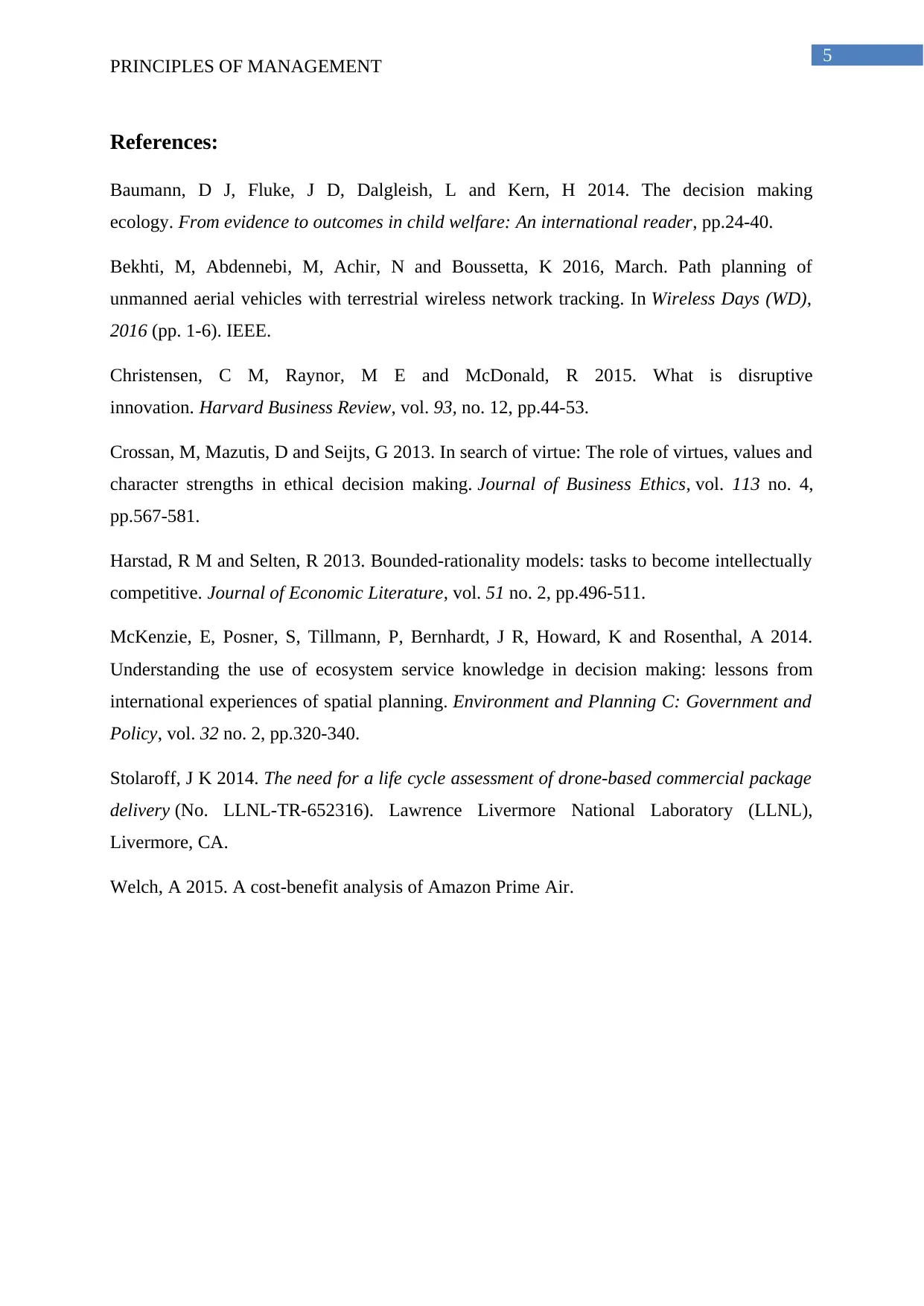
5
PRINCIPLES OF MANAGEMENT
References:
Baumann, D J, Fluke, J D, Dalgleish, L and Kern, H 2014. The decision making
ecology. From evidence to outcomes in child welfare: An international reader, pp.24-40.
Bekhti, M, Abdennebi, M, Achir, N and Boussetta, K 2016, March. Path planning of
unmanned aerial vehicles with terrestrial wireless network tracking. In Wireless Days (WD),
2016 (pp. 1-6). IEEE.
Christensen, C M, Raynor, M E and McDonald, R 2015. What is disruptive
innovation. Harvard Business Review, vol. 93, no. 12, pp.44-53.
Crossan, M, Mazutis, D and Seijts, G 2013. In search of virtue: The role of virtues, values and
character strengths in ethical decision making. Journal of Business Ethics, vol. 113 no. 4,
pp.567-581.
Harstad, R M and Selten, R 2013. Bounded-rationality models: tasks to become intellectually
competitive. Journal of Economic Literature, vol. 51 no. 2, pp.496-511.
McKenzie, E, Posner, S, Tillmann, P, Bernhardt, J R, Howard, K and Rosenthal, A 2014.
Understanding the use of ecosystem service knowledge in decision making: lessons from
international experiences of spatial planning. Environment and Planning C: Government and
Policy, vol. 32 no. 2, pp.320-340.
Stolaroff, J K 2014. The need for a life cycle assessment of drone-based commercial package
delivery (No. LLNL-TR-652316). Lawrence Livermore National Laboratory (LLNL),
Livermore, CA.
Welch, A 2015. A cost-benefit analysis of Amazon Prime Air.
PRINCIPLES OF MANAGEMENT
References:
Baumann, D J, Fluke, J D, Dalgleish, L and Kern, H 2014. The decision making
ecology. From evidence to outcomes in child welfare: An international reader, pp.24-40.
Bekhti, M, Abdennebi, M, Achir, N and Boussetta, K 2016, March. Path planning of
unmanned aerial vehicles with terrestrial wireless network tracking. In Wireless Days (WD),
2016 (pp. 1-6). IEEE.
Christensen, C M, Raynor, M E and McDonald, R 2015. What is disruptive
innovation. Harvard Business Review, vol. 93, no. 12, pp.44-53.
Crossan, M, Mazutis, D and Seijts, G 2013. In search of virtue: The role of virtues, values and
character strengths in ethical decision making. Journal of Business Ethics, vol. 113 no. 4,
pp.567-581.
Harstad, R M and Selten, R 2013. Bounded-rationality models: tasks to become intellectually
competitive. Journal of Economic Literature, vol. 51 no. 2, pp.496-511.
McKenzie, E, Posner, S, Tillmann, P, Bernhardt, J R, Howard, K and Rosenthal, A 2014.
Understanding the use of ecosystem service knowledge in decision making: lessons from
international experiences of spatial planning. Environment and Planning C: Government and
Policy, vol. 32 no. 2, pp.320-340.
Stolaroff, J K 2014. The need for a life cycle assessment of drone-based commercial package
delivery (No. LLNL-TR-652316). Lawrence Livermore National Laboratory (LLNL),
Livermore, CA.
Welch, A 2015. A cost-benefit analysis of Amazon Prime Air.
⊘ This is a preview!⊘
Do you want full access?
Subscribe today to unlock all pages.

Trusted by 1+ million students worldwide
1 out of 6
Related Documents
Your All-in-One AI-Powered Toolkit for Academic Success.
+13062052269
info@desklib.com
Available 24*7 on WhatsApp / Email
![[object Object]](/_next/static/media/star-bottom.7253800d.svg)
Unlock your academic potential
Copyright © 2020–2025 A2Z Services. All Rights Reserved. Developed and managed by ZUCOL.





